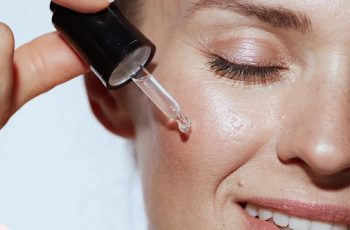The Science of Iron Oxide in Skin Care
Chances are, you’ve used a skin care or cosmetic product that contains iron oxide – but you may have not known it. Iron oxides are commonly found in tinted sunscreens and makeup products as a natural colorant. They also come along with a few key benefits to the skin, including the ability to block blue light from penetrating your skin and to help keep melasma and other forms of hyperpigmentation at bay.
Before we can help you decide if iron oxide-containing products could be right for your skin, make sure you know which of the 16 Baumann Skin Types you are first. Then, use the information in this guide as a starting point to decide if and how to incorporate them into your skin care regimen.
Iron oxides provide tint to many sunscreens and makeup products.
They also help to block blue light from penetrating your skin.
This blue light-blocking ability makes iron oxides helpful at preventing melasma.
What Is Iron Oxide?
Iron oxides, also called ferric oxides, are naturally occurring minerals found in various natural colors, though red is the most common hue used in cosmetics. In skin care and cosmetics, iron oxides are used as pigments to give products a natural tint without synthetic dyes. They are also UV-stable and resistant to oxidation, so they maintain their color in sunlight and don’t easily degrade.
The iron oxides used in cosmetic products are processed to remove impurities, making them safe for cosmetic use. There are three main types of iron oxide pigments commonly used in skin care:
CI 77491 (red)
CI 77492 (yellow
CI 77499 (black)
Skin Benefits
While they are most commonly used as a tint for sunscreens and makeup, iron oxides also have a few other key benefits for your skin:
Blocks blue light. Blue light has very short, high-energy waves, so it is able to penetrate deeper into the skin than UVB and UVA rays. Here, blue light can stimulate melanocytes (the cells that produce melanin), which trigger melanin production. This can cause dark spots and other forms of hyperpigmentation like melasma. Iron oxides form a physical barrier over the skip and are able to reflect and scatter blue light, thus reducing its effects on melanocytes and preventing excessive pigmentation.
Helps to prevent melasma. This ability to shield skin from blue light helps to reduce hyperpigmentation, including melasma. Melasma is often worsened by blue light, which is why dermatologists like Dr. Baumann often recommend tinted sunscreens that contain iron oxides to help prevent melasma from recurring.
Antioxidant protection. Studies have found that certain iron oxide nanoparticles have the potential to provide antioxidant protection by reducing oxidative stress, a process in which free radicals damage skin cells and accelerate aging (3).
Side Effects
Iron oxide is considered safe for cosmetic use and has a low hazard rating on the Environmental Working Group (EWG) Skin Deep database. Unlike some chemical sunscreen ingredients and colorants, iron oxides are non-irritating and are generally safe for sensitive skin types. Iron oxides are also non-comedogenic, so they’re unlikely to clog pores.
However, as with any ingredient, there is a small chance of an allergic reaction to certain iron oxides, although this is rare.
Sunscreens with Iron Oxide
Mineral sunscreens, also called physical sunscreens, are a great chemical-free alternative to traditional chemical sunscreens. Mineral sunscreens contain ingredients like zinc oxide and/or titanium dioxide to reflect UV rays away from your skin. However, one of the challenges with these sunscreens is that they tend to create a white hue on the skin. Iron oxides can be added to mineral sunscreens to provide a natural tint that helps to blend the sunscreen with your skin tone for a clearer, smoother finish.
As an added bonus, tinted sunscreens with iron oxide offer both UV and blue light protection, making them ideal for people with melasma or those who spend a lot of time in front of a computer screen.
Some of the best mineral sunscreens that contain iron oxide include:
Iron Oxide in Makeup
Iron oxide is also widely used in makeup products like foundations, BB creams, and concealers to provide natural tints. While these products can provide some sun protection, don’t rely on these products alone for full UV protection. This is because you would have to apply much more makeup than most people are comfortable with applying in order to reach the necessary SPF to keep your skin protected.
To keep your skin protected from both sun damage and blue light, you can layer makeup with an SPF sunscreen underneath, or use a tinted sunscreen as a base.
Bottom Line
Iron oxide is a common ingredient used in many sunscreens and makeups to provide a natural tint. In addition to its use as a natural pigment, iron oxide also provides benefits such as blocking blue light and helping to prevent melasma and other forms of hyperpigmentation. Choosing a sunscreen that contains iron oxides can protect your skin against both UV light and blue light. Just be sure you are choosing a sunscreen that is right for your skin type so that you will wear it every day!
DQH Can I use salicylic acid first and then vitamin C?
It’s easy to create a skincare routine, but knowing how to use it is another thing entirely. In most cases, if you’re not getting the desired skin results, it could be due to the layering of conflicting ingredients. So, is it possible that salicylic acid and vitamin C are such ingredients? Or are these active ingredients the duo that’s been missing from your skincare routine? If you want answers, stick around because today we are going to explain the benefits of salicylic acid and vitamin C and how they can be used in your daily life.
What are the benefits of salicylic acid for skin?
Salicylic acid is one of the most commonly used beta hydroxy acids and is favored by many people with oily, acne-prone skin. This acid is derived from willow bark, and unlike its water-soluble relatives (called alpha-hydroxy acids), salicylic acid is oil-soluble, which means it can penetrate deeper into the lower layers of the skin. Once it reaches the lower layers, it can help unclog pores of excess sebum, dirt, bacteria, debris, and impurities. This results in clearer skin tones and greater definition.
Not only does salicylic acid benefit the underlying layers, but the outer surface of the skin benefits as well. When applied to the skin, salicylic acid removes the buildup of dead skin cells. This is accomplished by breaking the bonds that hold dead cells to the surface. Over time, this can cause the complexion to look dull and prone to acne, blackheads, and other blemishes.
If you’d like to learn more about salicylic acid and how it can improve your skin, check out this dedicated blog post from a beauty insider.
What are the benefits of vitamin C for skin?
Vitamin C is considered one of the most powerful antioxidants, which means it is very effective at fighting free radicals and preventing them from causing further skin damage. Examples of free radicals include pollution, central heating, UV rays and harsh climate. They attack proteins, fats and cell membranes as soon as they come into contact with the skin, causing signs of premature aging such as fine lines and wrinkles as well as hyperpigmentation, flaky patches of skin and loss of elasticity.
Many people usually prefer to use vitamin C in their morning routine as this ingredient gives the complexion a radiant glow. You’ll also find that vitamin C can target areas of hyperpigmentation, plumping the skin and reducing the appearance of fine lines and wrinkles.
The thing about vitamin C is that there are a lot of outdated studies going back to the 1950s that describe vitamin C as an unstable skin component. Thanks to improvements in modern technology, this is no longer the case as all products now contain a stable form of vitamin C.
Visit The Beauty Insider to learn more about vitamin C. So please check out our blog post.
Can I use salicylic acid first and then vitamin C?
Yes, you absolutely can. In fact, it’s thought that using salicylic acid before using vitamin C ensures it penetrates faster and works faster.
This is an efficient way to utilize two power sources, and the reason has to do with pH. For example, the skin’s natural pH is about 4.7, making it slightly acidic. Salicylic acid and vitamin C are also both acidic, and you’ll find that vitamin C is absorbed quickly into the skin. Therefore, using salicylic acid beforehand can increase the acidity of the skin and allow vitamin C to penetrate into the skin faster.
While this is considered an effective way to combine two powerful ingredients, you need to be aware of your skin type and how it reacts to certain active ingredients. Even people with perfect, normal skin can experience skin sensitivity and irritation. Therefore, always consult a doctor or dermatologist before using any new products on your skin.
It’s also important to follow skin application rules. In this case, you need to use the product correctly to ensure you get the best results for your skin. If you’re not sure what I mean, the basic rule for skin is to start with the thinnest consistency and work your way up to the thickest consistency. This prevents a barrier from forming on the surface, preventing other active ingredients from penetrating the skin.
Can I use salicylic acid at night and vitamin C in the morning?
Yes, absolutely, this is considered the most effective way to get returns without any adverse side effects. This is because there is enough time between applications to ensure that the skin’s pH levels return to balance.
You’ll also find that Vitamin C is rich in antioxidants and is perfect for use in the morning to ensure your skin is protected and looking its healthiest. Due to the small size of salicylic acid molecules, it is an acid that is able to reach the deepest parts of the skin. While this is effective at keeping skin clear, it also increases the risk of irritation and photosensitivity. Therefore, many people prefer to use powerful BHAs in their evening routine without exposure to UV rays, pollution, or harsh weather.
Warning: If you avoid using sunscreen every day, none of these ingredients will do what your skin needs. The combination of chemical peels and powerful ingredients increases the risk of further damage to the skin’s surface. Use SPF 50 every day to keep your skin protected and your lipid barrier healthy, even on cloudy days, keeping your skin in top condition.



